Marketing Research Essentials: Customer Satisfaction in Healthcare
VerifiedAdded on 2023/06/05
|14
|2680
|357
Report
AI Summary
This report, titled "Marketing Research Essentials: Factors Influencing Customer Satisfaction in Health Care Services," presents a comprehensive investigation into the elements that contribute to patient satisfaction within the healthcare sector. The research employs a quantitative approach, utilizing surveys and questionnaires administered to 250 physiotherapy patients in Queensland, Australia. The study aims to identify the relationships between independent variables such as medical services, financial issues, and service quality, and the dependent variable, customer satisfaction. The methodology includes both primary and secondary data collection, with statistical analysis employed to interpret the findings. The report details the study's objectives, hypotheses, study population, procedures, and proposed outcomes, including data collection methods, risk/benefit analysis, statistical analysis, ethical considerations, and financial resource allocation. The research intends to disseminate its findings through publications and aims to provide valuable insights for healthcare providers seeking to improve patient satisfaction. The report also includes references and appendices to support the research findings and methodology.
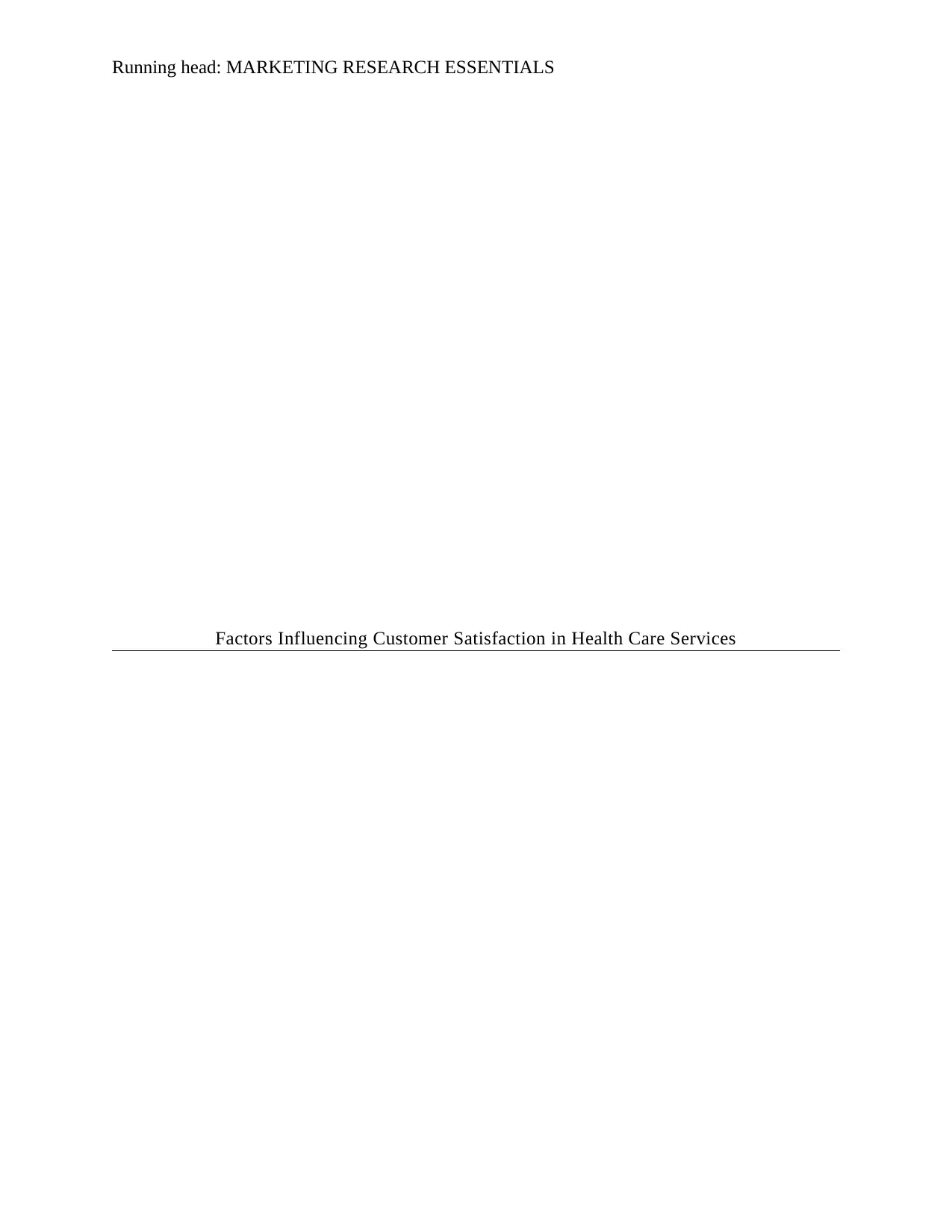
Running head: MARKETING RESEARCH ESSENTIALS
Factors Influencing Customer Satisfaction in Health Care Services
Factors Influencing Customer Satisfaction in Health Care Services
Paraphrase This Document
Need a fresh take? Get an instant paraphrase of this document with our AI Paraphraser
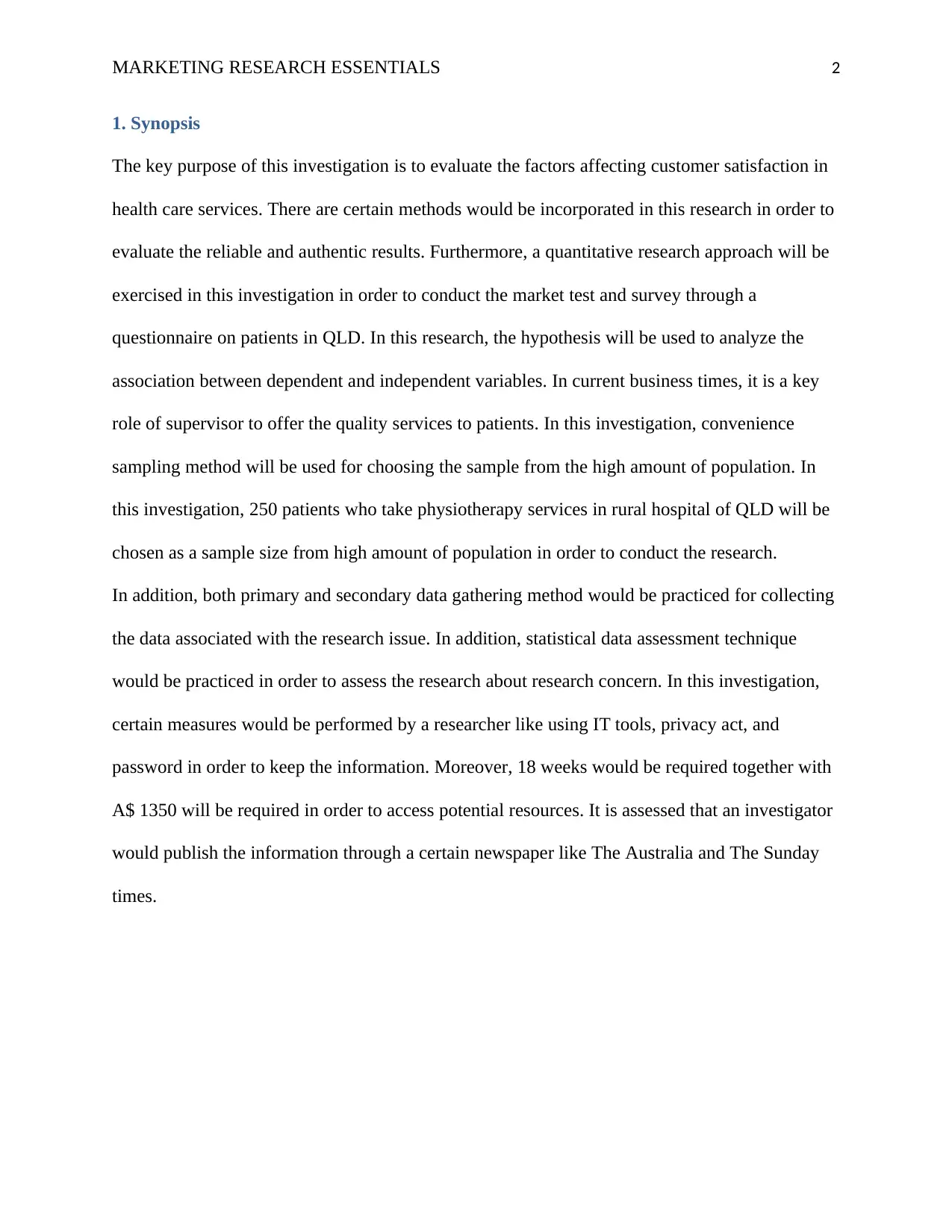
MARKETING RESEARCH ESSENTIALS 2
1. Synopsis
The key purpose of this investigation is to evaluate the factors affecting customer satisfaction in
health care services. There are certain methods would be incorporated in this research in order to
evaluate the reliable and authentic results. Furthermore, a quantitative research approach will be
exercised in this investigation in order to conduct the market test and survey through a
questionnaire on patients in QLD. In this research, the hypothesis will be used to analyze the
association between dependent and independent variables. In current business times, it is a key
role of supervisor to offer the quality services to patients. In this investigation, convenience
sampling method will be used for choosing the sample from the high amount of population. In
this investigation, 250 patients who take physiotherapy services in rural hospital of QLD will be
chosen as a sample size from high amount of population in order to conduct the research.
In addition, both primary and secondary data gathering method would be practiced for collecting
the data associated with the research issue. In addition, statistical data assessment technique
would be practiced in order to assess the research about research concern. In this investigation,
certain measures would be performed by a researcher like using IT tools, privacy act, and
password in order to keep the information. Moreover, 18 weeks would be required together with
A$ 1350 will be required in order to access potential resources. It is assessed that an investigator
would publish the information through a certain newspaper like The Australia and The Sunday
times.
1. Synopsis
The key purpose of this investigation is to evaluate the factors affecting customer satisfaction in
health care services. There are certain methods would be incorporated in this research in order to
evaluate the reliable and authentic results. Furthermore, a quantitative research approach will be
exercised in this investigation in order to conduct the market test and survey through a
questionnaire on patients in QLD. In this research, the hypothesis will be used to analyze the
association between dependent and independent variables. In current business times, it is a key
role of supervisor to offer the quality services to patients. In this investigation, convenience
sampling method will be used for choosing the sample from the high amount of population. In
this investigation, 250 patients who take physiotherapy services in rural hospital of QLD will be
chosen as a sample size from high amount of population in order to conduct the research.
In addition, both primary and secondary data gathering method would be practiced for collecting
the data associated with the research issue. In addition, statistical data assessment technique
would be practiced in order to assess the research about research concern. In this investigation,
certain measures would be performed by a researcher like using IT tools, privacy act, and
password in order to keep the information. Moreover, 18 weeks would be required together with
A$ 1350 will be required in order to access potential resources. It is assessed that an investigator
would publish the information through a certain newspaper like The Australia and The Sunday
times.
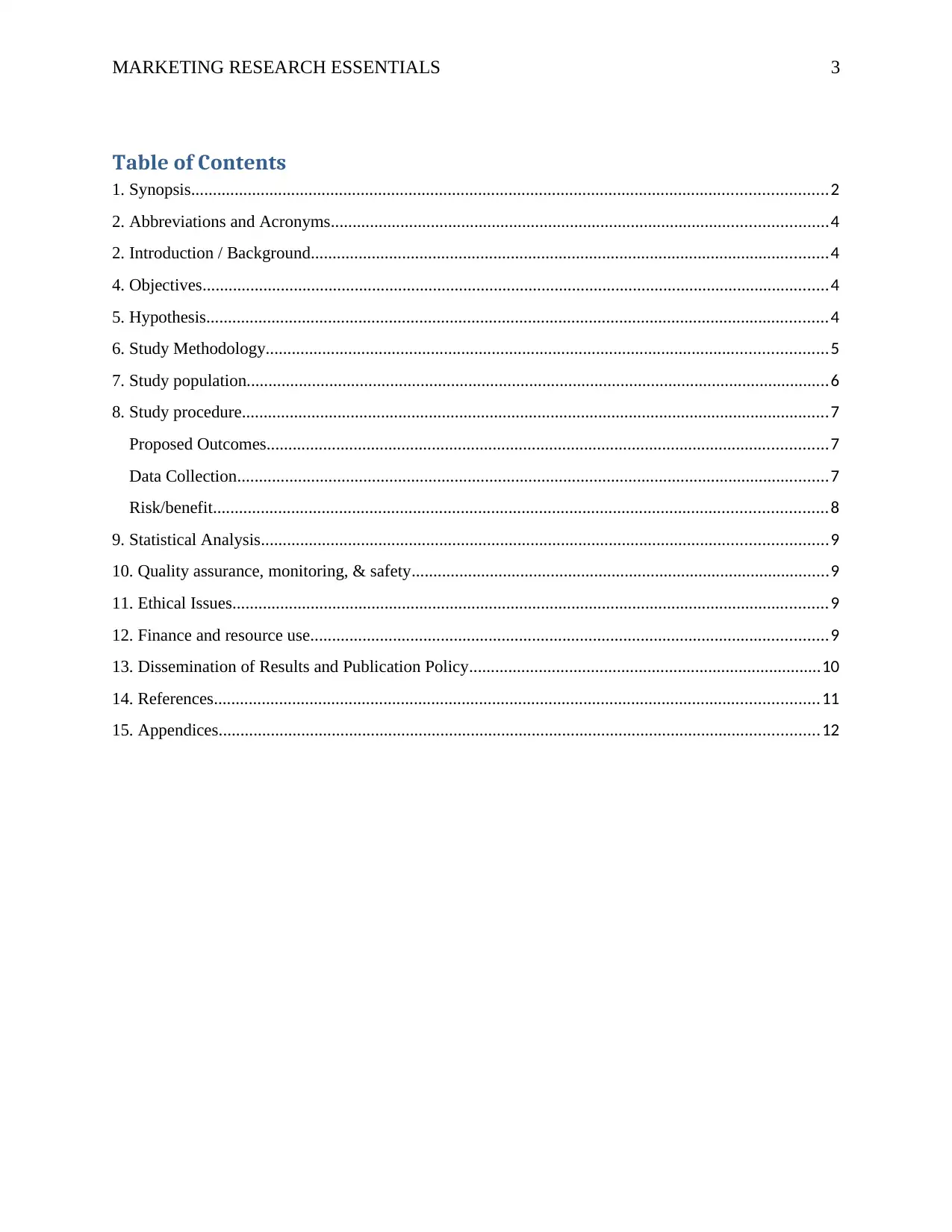
MARKETING RESEARCH ESSENTIALS 3
Table of Contents
1. Synopsis..................................................................................................................................................2
2. Abbreviations and Acronyms..................................................................................................................4
2. Introduction / Background.......................................................................................................................4
4. Objectives................................................................................................................................................4
5. Hypothesis...............................................................................................................................................4
6. Study Methodology.................................................................................................................................5
7. Study population......................................................................................................................................6
8. Study procedure.......................................................................................................................................7
Proposed Outcomes.................................................................................................................................7
Data Collection........................................................................................................................................7
Risk/benefit.............................................................................................................................................8
9. Statistical Analysis..................................................................................................................................9
10. Quality assurance, monitoring, & safety................................................................................................9
11. Ethical Issues.........................................................................................................................................9
12. Finance and resource use.......................................................................................................................9
13. Dissemination of Results and Publication Policy.................................................................................10
14. References...........................................................................................................................................11
15. Appendices..........................................................................................................................................12
Table of Contents
1. Synopsis..................................................................................................................................................2
2. Abbreviations and Acronyms..................................................................................................................4
2. Introduction / Background.......................................................................................................................4
4. Objectives................................................................................................................................................4
5. Hypothesis...............................................................................................................................................4
6. Study Methodology.................................................................................................................................5
7. Study population......................................................................................................................................6
8. Study procedure.......................................................................................................................................7
Proposed Outcomes.................................................................................................................................7
Data Collection........................................................................................................................................7
Risk/benefit.............................................................................................................................................8
9. Statistical Analysis..................................................................................................................................9
10. Quality assurance, monitoring, & safety................................................................................................9
11. Ethical Issues.........................................................................................................................................9
12. Finance and resource use.......................................................................................................................9
13. Dissemination of Results and Publication Policy.................................................................................10
14. References...........................................................................................................................................11
15. Appendices..........................................................................................................................................12
⊘ This is a preview!⊘
Do you want full access?
Subscribe today to unlock all pages.

Trusted by 1+ million students worldwide
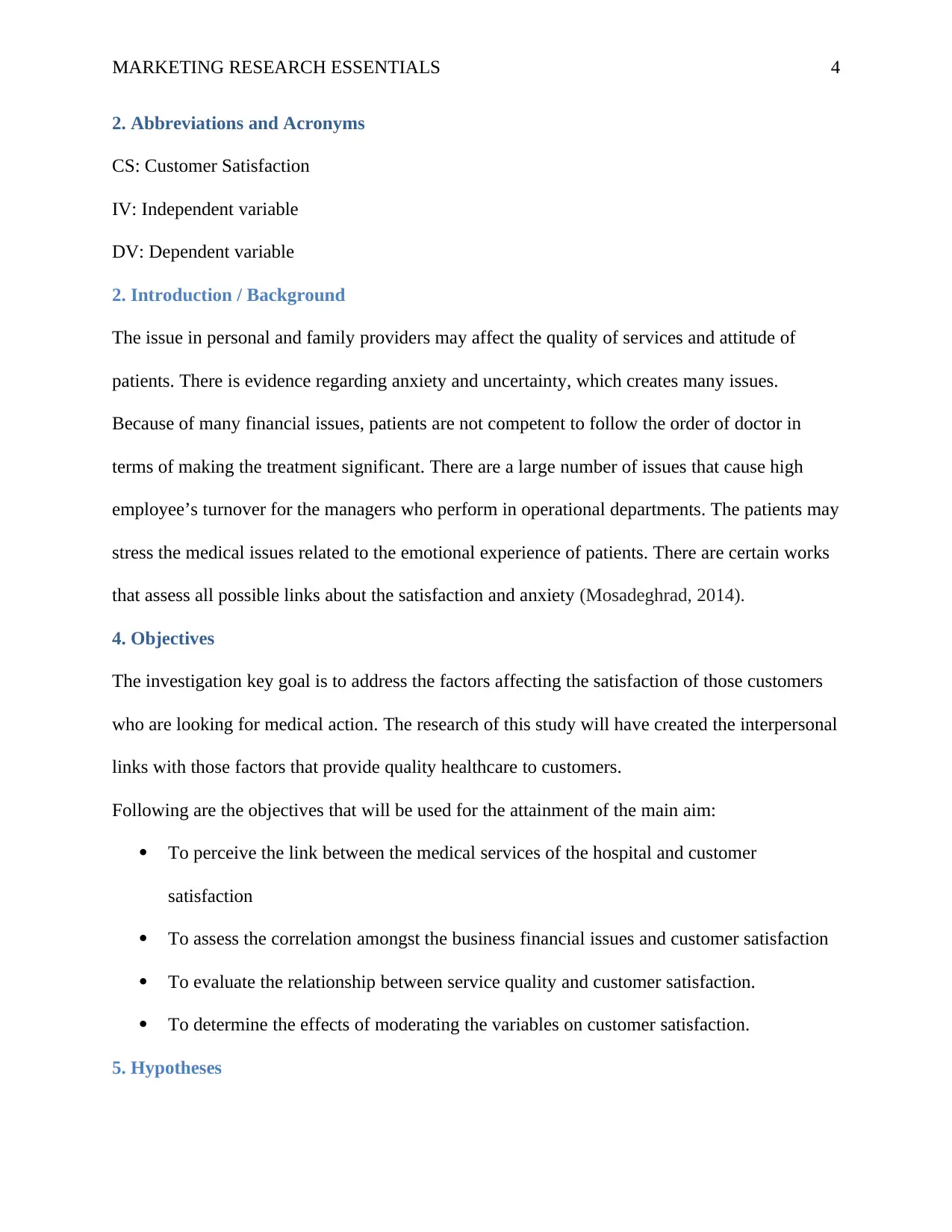
MARKETING RESEARCH ESSENTIALS 4
2. Abbreviations and Acronyms
CS: Customer Satisfaction
IV: Independent variable
DV: Dependent variable
2. Introduction / Background
The issue in personal and family providers may affect the quality of services and attitude of
patients. There is evidence regarding anxiety and uncertainty, which creates many issues.
Because of many financial issues, patients are not competent to follow the order of doctor in
terms of making the treatment significant. There are a large number of issues that cause high
employee’s turnover for the managers who perform in operational departments. The patients may
stress the medical issues related to the emotional experience of patients. There are certain works
that assess all possible links about the satisfaction and anxiety (Mosadeghrad, 2014).
4. Objectives
The investigation key goal is to address the factors affecting the satisfaction of those customers
who are looking for medical action. The research of this study will have created the interpersonal
links with those factors that provide quality healthcare to customers.
Following are the objectives that will be used for the attainment of the main aim:
To perceive the link between the medical services of the hospital and customer
satisfaction
To assess the correlation amongst the business financial issues and customer satisfaction
To evaluate the relationship between service quality and customer satisfaction.
To determine the effects of moderating the variables on customer satisfaction.
5. Hypotheses
2. Abbreviations and Acronyms
CS: Customer Satisfaction
IV: Independent variable
DV: Dependent variable
2. Introduction / Background
The issue in personal and family providers may affect the quality of services and attitude of
patients. There is evidence regarding anxiety and uncertainty, which creates many issues.
Because of many financial issues, patients are not competent to follow the order of doctor in
terms of making the treatment significant. There are a large number of issues that cause high
employee’s turnover for the managers who perform in operational departments. The patients may
stress the medical issues related to the emotional experience of patients. There are certain works
that assess all possible links about the satisfaction and anxiety (Mosadeghrad, 2014).
4. Objectives
The investigation key goal is to address the factors affecting the satisfaction of those customers
who are looking for medical action. The research of this study will have created the interpersonal
links with those factors that provide quality healthcare to customers.
Following are the objectives that will be used for the attainment of the main aim:
To perceive the link between the medical services of the hospital and customer
satisfaction
To assess the correlation amongst the business financial issues and customer satisfaction
To evaluate the relationship between service quality and customer satisfaction.
To determine the effects of moderating the variables on customer satisfaction.
5. Hypotheses
Paraphrase This Document
Need a fresh take? Get an instant paraphrase of this document with our AI Paraphraser
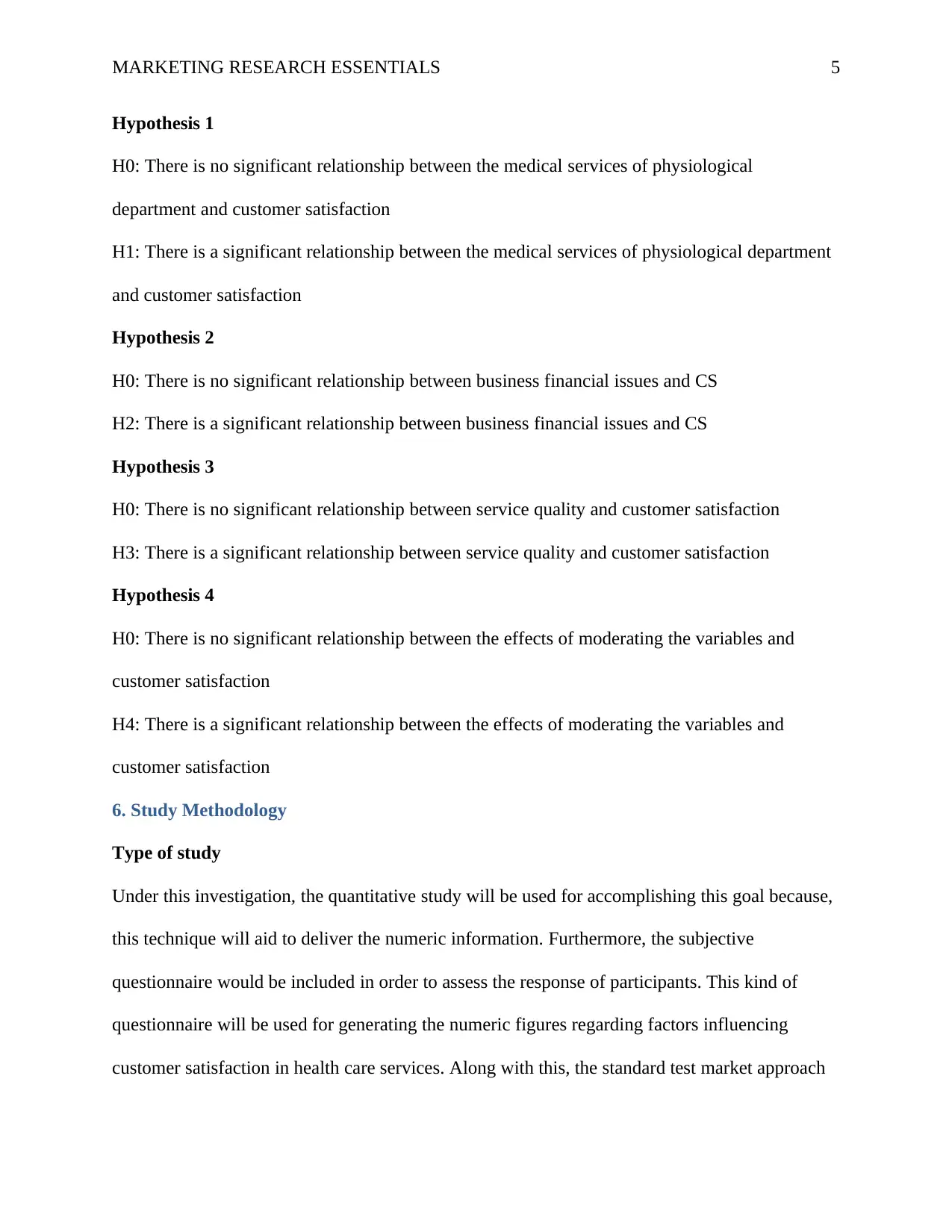
MARKETING RESEARCH ESSENTIALS 5
Hypothesis 1
H0: There is no significant relationship between the medical services of physiological
department and customer satisfaction
H1: There is a significant relationship between the medical services of physiological department
and customer satisfaction
Hypothesis 2
H0: There is no significant relationship between business financial issues and CS
H2: There is a significant relationship between business financial issues and CS
Hypothesis 3
H0: There is no significant relationship between service quality and customer satisfaction
H3: There is a significant relationship between service quality and customer satisfaction
Hypothesis 4
H0: There is no significant relationship between the effects of moderating the variables and
customer satisfaction
H4: There is a significant relationship between the effects of moderating the variables and
customer satisfaction
6. Study Methodology
Type of study
Under this investigation, the quantitative study will be used for accomplishing this goal because,
this technique will aid to deliver the numeric information. Furthermore, the subjective
questionnaire would be included in order to assess the response of participants. This kind of
questionnaire will be used for generating the numeric figures regarding factors influencing
customer satisfaction in health care services. Along with this, the standard test market approach
Hypothesis 1
H0: There is no significant relationship between the medical services of physiological
department and customer satisfaction
H1: There is a significant relationship between the medical services of physiological department
and customer satisfaction
Hypothesis 2
H0: There is no significant relationship between business financial issues and CS
H2: There is a significant relationship between business financial issues and CS
Hypothesis 3
H0: There is no significant relationship between service quality and customer satisfaction
H3: There is a significant relationship between service quality and customer satisfaction
Hypothesis 4
H0: There is no significant relationship between the effects of moderating the variables and
customer satisfaction
H4: There is a significant relationship between the effects of moderating the variables and
customer satisfaction
6. Study Methodology
Type of study
Under this investigation, the quantitative study will be used for accomplishing this goal because,
this technique will aid to deliver the numeric information. Furthermore, the subjective
questionnaire would be included in order to assess the response of participants. This kind of
questionnaire will be used for generating the numeric figures regarding factors influencing
customer satisfaction in health care services. Along with this, the standard test market approach
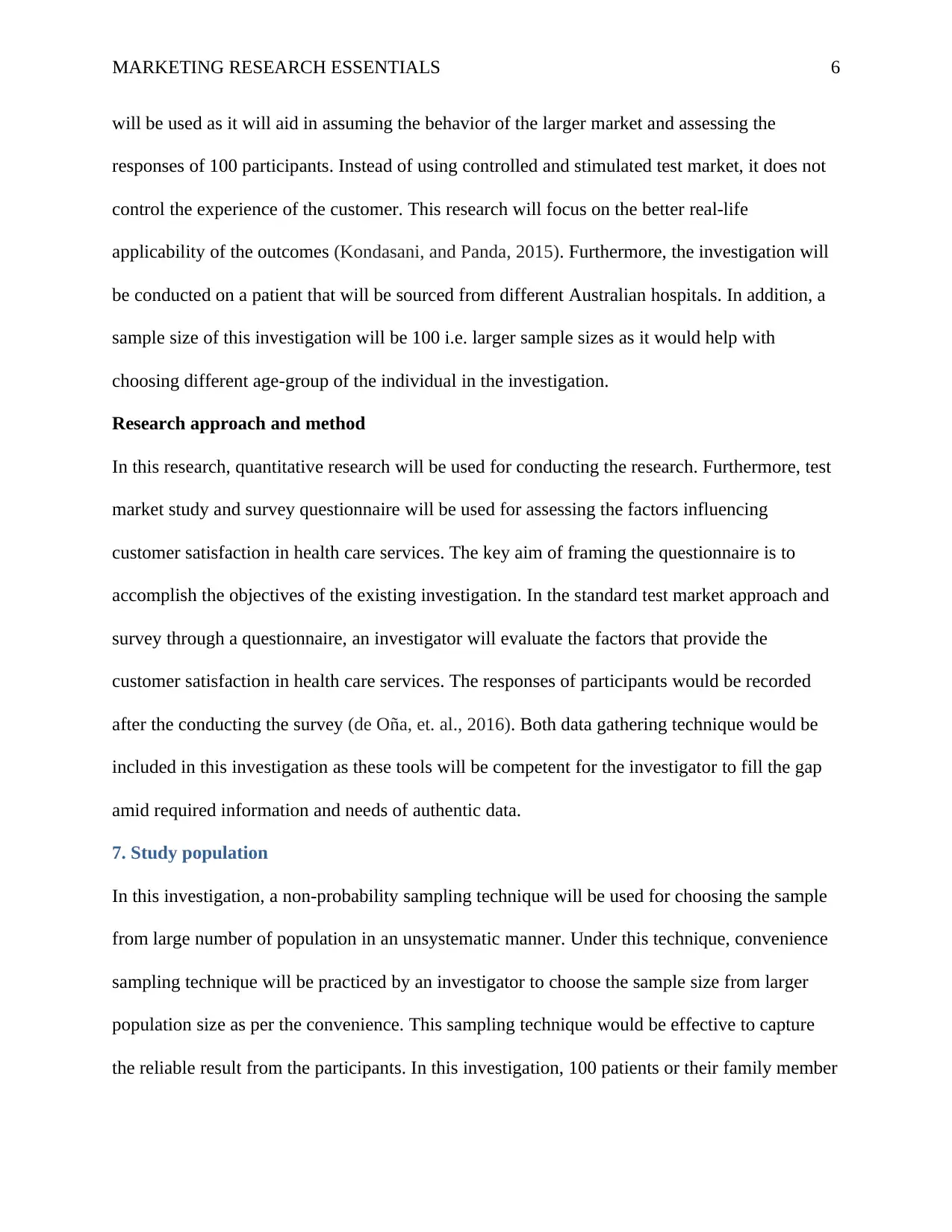
MARKETING RESEARCH ESSENTIALS 6
will be used as it will aid in assuming the behavior of the larger market and assessing the
responses of 100 participants. Instead of using controlled and stimulated test market, it does not
control the experience of the customer. This research will focus on the better real-life
applicability of the outcomes (Kondasani, and Panda, 2015). Furthermore, the investigation will
be conducted on a patient that will be sourced from different Australian hospitals. In addition, a
sample size of this investigation will be 100 i.e. larger sample sizes as it would help with
choosing different age-group of the individual in the investigation.
Research approach and method
In this research, quantitative research will be used for conducting the research. Furthermore, test
market study and survey questionnaire will be used for assessing the factors influencing
customer satisfaction in health care services. The key aim of framing the questionnaire is to
accomplish the objectives of the existing investigation. In the standard test market approach and
survey through a questionnaire, an investigator will evaluate the factors that provide the
customer satisfaction in health care services. The responses of participants would be recorded
after the conducting the survey (de Oña, et. al., 2016). Both data gathering technique would be
included in this investigation as these tools will be competent for the investigator to fill the gap
amid required information and needs of authentic data.
7. Study population
In this investigation, a non-probability sampling technique will be used for choosing the sample
from large number of population in an unsystematic manner. Under this technique, convenience
sampling technique will be practiced by an investigator to choose the sample size from larger
population size as per the convenience. This sampling technique would be effective to capture
the reliable result from the participants. In this investigation, 100 patients or their family member
will be used as it will aid in assuming the behavior of the larger market and assessing the
responses of 100 participants. Instead of using controlled and stimulated test market, it does not
control the experience of the customer. This research will focus on the better real-life
applicability of the outcomes (Kondasani, and Panda, 2015). Furthermore, the investigation will
be conducted on a patient that will be sourced from different Australian hospitals. In addition, a
sample size of this investigation will be 100 i.e. larger sample sizes as it would help with
choosing different age-group of the individual in the investigation.
Research approach and method
In this research, quantitative research will be used for conducting the research. Furthermore, test
market study and survey questionnaire will be used for assessing the factors influencing
customer satisfaction in health care services. The key aim of framing the questionnaire is to
accomplish the objectives of the existing investigation. In the standard test market approach and
survey through a questionnaire, an investigator will evaluate the factors that provide the
customer satisfaction in health care services. The responses of participants would be recorded
after the conducting the survey (de Oña, et. al., 2016). Both data gathering technique would be
included in this investigation as these tools will be competent for the investigator to fill the gap
amid required information and needs of authentic data.
7. Study population
In this investigation, a non-probability sampling technique will be used for choosing the sample
from large number of population in an unsystematic manner. Under this technique, convenience
sampling technique will be practiced by an investigator to choose the sample size from larger
population size as per the convenience. This sampling technique would be effective to capture
the reliable result from the participants. In this investigation, 100 patients or their family member
⊘ This is a preview!⊘
Do you want full access?
Subscribe today to unlock all pages.

Trusted by 1+ million students worldwide
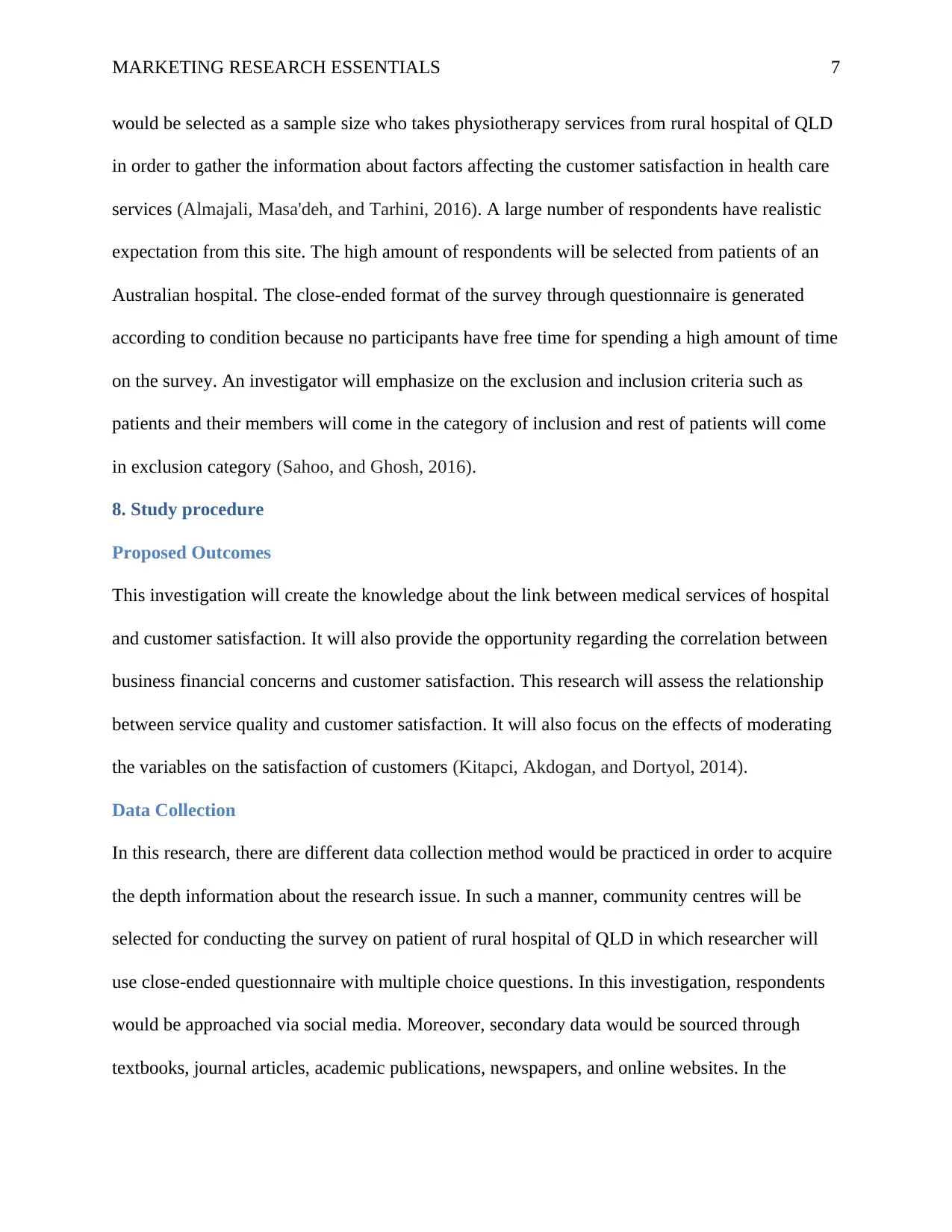
MARKETING RESEARCH ESSENTIALS 7
would be selected as a sample size who takes physiotherapy services from rural hospital of QLD
in order to gather the information about factors affecting the customer satisfaction in health care
services (Almajali, Masa'deh, and Tarhini, 2016). A large number of respondents have realistic
expectation from this site. The high amount of respondents will be selected from patients of an
Australian hospital. The close-ended format of the survey through questionnaire is generated
according to condition because no participants have free time for spending a high amount of time
on the survey. An investigator will emphasize on the exclusion and inclusion criteria such as
patients and their members will come in the category of inclusion and rest of patients will come
in exclusion category (Sahoo, and Ghosh, 2016).
8. Study procedure
Proposed Outcomes
This investigation will create the knowledge about the link between medical services of hospital
and customer satisfaction. It will also provide the opportunity regarding the correlation between
business financial concerns and customer satisfaction. This research will assess the relationship
between service quality and customer satisfaction. It will also focus on the effects of moderating
the variables on the satisfaction of customers (Kitapci, Akdogan, and Dortyol, 2014).
Data Collection
In this research, there are different data collection method would be practiced in order to acquire
the depth information about the research issue. In such a manner, community centres will be
selected for conducting the survey on patient of rural hospital of QLD in which researcher will
use close-ended questionnaire with multiple choice questions. In this investigation, respondents
would be approached via social media. Moreover, secondary data would be sourced through
textbooks, journal articles, academic publications, newspapers, and online websites. In the
would be selected as a sample size who takes physiotherapy services from rural hospital of QLD
in order to gather the information about factors affecting the customer satisfaction in health care
services (Almajali, Masa'deh, and Tarhini, 2016). A large number of respondents have realistic
expectation from this site. The high amount of respondents will be selected from patients of an
Australian hospital. The close-ended format of the survey through questionnaire is generated
according to condition because no participants have free time for spending a high amount of time
on the survey. An investigator will emphasize on the exclusion and inclusion criteria such as
patients and their members will come in the category of inclusion and rest of patients will come
in exclusion category (Sahoo, and Ghosh, 2016).
8. Study procedure
Proposed Outcomes
This investigation will create the knowledge about the link between medical services of hospital
and customer satisfaction. It will also provide the opportunity regarding the correlation between
business financial concerns and customer satisfaction. This research will assess the relationship
between service quality and customer satisfaction. It will also focus on the effects of moderating
the variables on the satisfaction of customers (Kitapci, Akdogan, and Dortyol, 2014).
Data Collection
In this research, there are different data collection method would be practiced in order to acquire
the depth information about the research issue. In such a manner, community centres will be
selected for conducting the survey on patient of rural hospital of QLD in which researcher will
use close-ended questionnaire with multiple choice questions. In this investigation, respondents
would be approached via social media. Moreover, secondary data would be sourced through
textbooks, journal articles, academic publications, newspapers, and online websites. In the
Paraphrase This Document
Need a fresh take? Get an instant paraphrase of this document with our AI Paraphraser
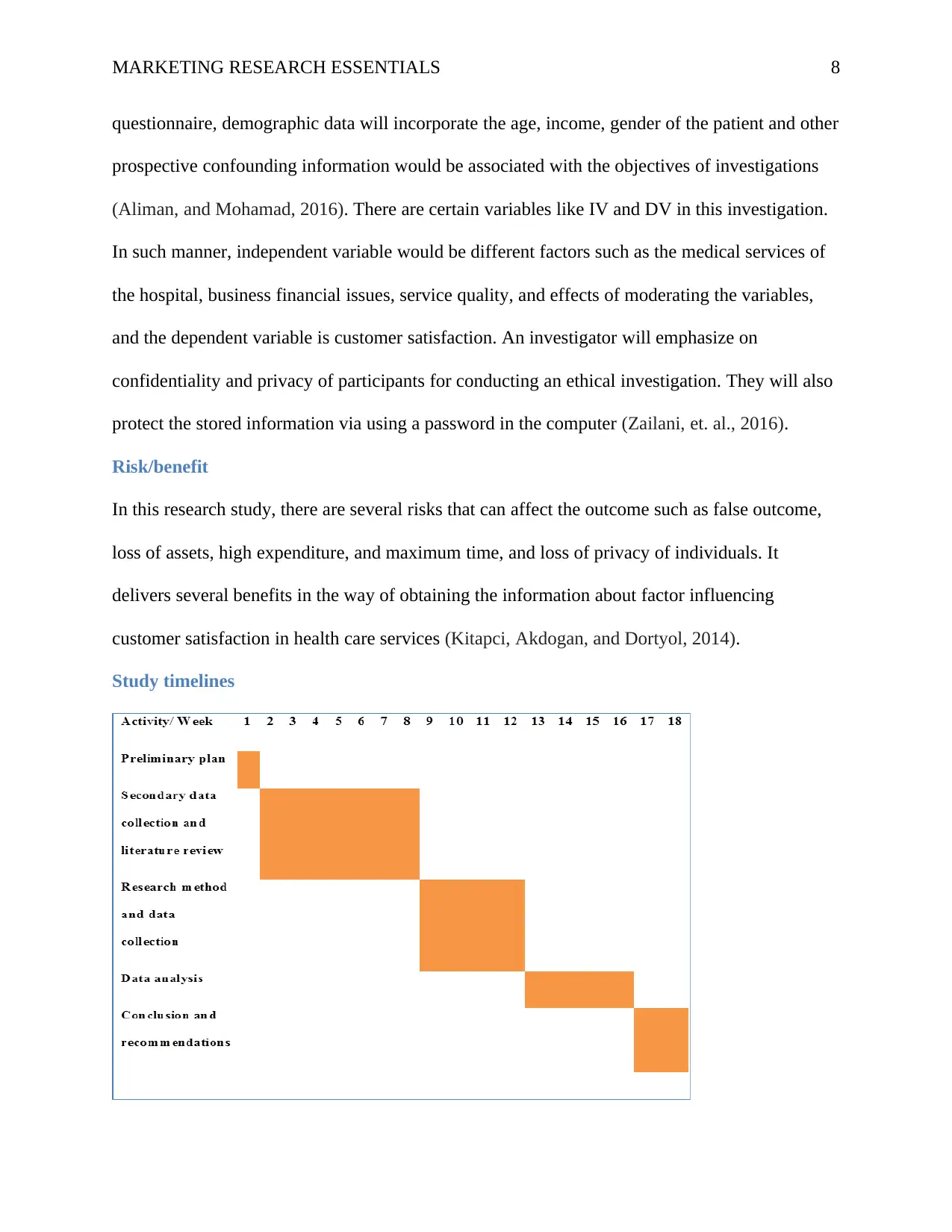
MARKETING RESEARCH ESSENTIALS 8
questionnaire, demographic data will incorporate the age, income, gender of the patient and other
prospective confounding information would be associated with the objectives of investigations
(Aliman, and Mohamad, 2016). There are certain variables like IV and DV in this investigation.
In such manner, independent variable would be different factors such as the medical services of
the hospital, business financial issues, service quality, and effects of moderating the variables,
and the dependent variable is customer satisfaction. An investigator will emphasize on
confidentiality and privacy of participants for conducting an ethical investigation. They will also
protect the stored information via using a password in the computer (Zailani, et. al., 2016).
Risk/benefit
In this research study, there are several risks that can affect the outcome such as false outcome,
loss of assets, high expenditure, and maximum time, and loss of privacy of individuals. It
delivers several benefits in the way of obtaining the information about factor influencing
customer satisfaction in health care services (Kitapci, Akdogan, and Dortyol, 2014).
Study timelines
questionnaire, demographic data will incorporate the age, income, gender of the patient and other
prospective confounding information would be associated with the objectives of investigations
(Aliman, and Mohamad, 2016). There are certain variables like IV and DV in this investigation.
In such manner, independent variable would be different factors such as the medical services of
the hospital, business financial issues, service quality, and effects of moderating the variables,
and the dependent variable is customer satisfaction. An investigator will emphasize on
confidentiality and privacy of participants for conducting an ethical investigation. They will also
protect the stored information via using a password in the computer (Zailani, et. al., 2016).
Risk/benefit
In this research study, there are several risks that can affect the outcome such as false outcome,
loss of assets, high expenditure, and maximum time, and loss of privacy of individuals. It
delivers several benefits in the way of obtaining the information about factor influencing
customer satisfaction in health care services (Kitapci, Akdogan, and Dortyol, 2014).
Study timelines
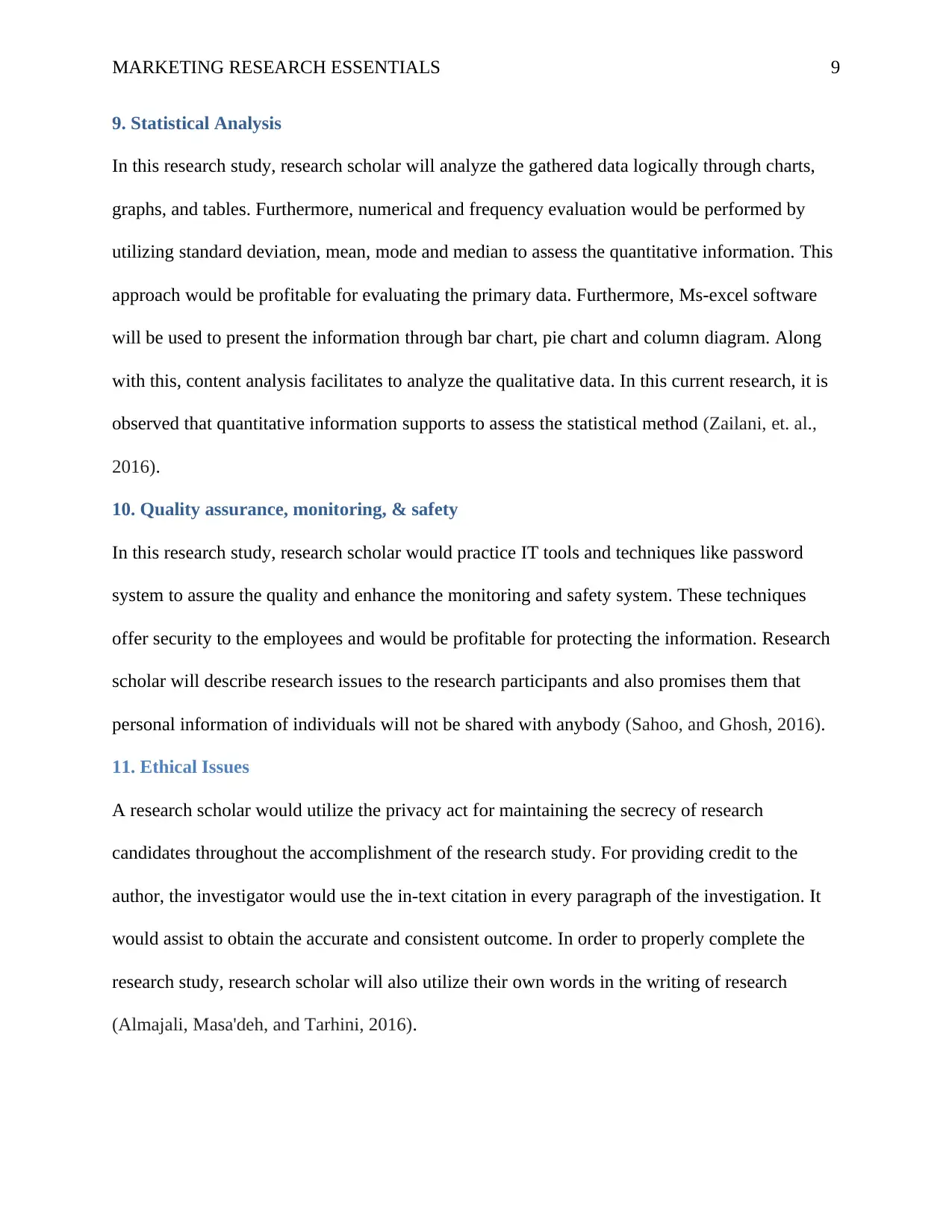
MARKETING RESEARCH ESSENTIALS 9
9. Statistical Analysis
In this research study, research scholar will analyze the gathered data logically through charts,
graphs, and tables. Furthermore, numerical and frequency evaluation would be performed by
utilizing standard deviation, mean, mode and median to assess the quantitative information. This
approach would be profitable for evaluating the primary data. Furthermore, Ms-excel software
will be used to present the information through bar chart, pie chart and column diagram. Along
with this, content analysis facilitates to analyze the qualitative data. In this current research, it is
observed that quantitative information supports to assess the statistical method (Zailani, et. al.,
2016).
10. Quality assurance, monitoring, & safety
In this research study, research scholar would practice IT tools and techniques like password
system to assure the quality and enhance the monitoring and safety system. These techniques
offer security to the employees and would be profitable for protecting the information. Research
scholar will describe research issues to the research participants and also promises them that
personal information of individuals will not be shared with anybody (Sahoo, and Ghosh, 2016).
11. Ethical Issues
A research scholar would utilize the privacy act for maintaining the secrecy of research
candidates throughout the accomplishment of the research study. For providing credit to the
author, the investigator would use the in-text citation in every paragraph of the investigation. It
would assist to obtain the accurate and consistent outcome. In order to properly complete the
research study, research scholar will also utilize their own words in the writing of research
(Almajali, Masa'deh, and Tarhini, 2016).
9. Statistical Analysis
In this research study, research scholar will analyze the gathered data logically through charts,
graphs, and tables. Furthermore, numerical and frequency evaluation would be performed by
utilizing standard deviation, mean, mode and median to assess the quantitative information. This
approach would be profitable for evaluating the primary data. Furthermore, Ms-excel software
will be used to present the information through bar chart, pie chart and column diagram. Along
with this, content analysis facilitates to analyze the qualitative data. In this current research, it is
observed that quantitative information supports to assess the statistical method (Zailani, et. al.,
2016).
10. Quality assurance, monitoring, & safety
In this research study, research scholar would practice IT tools and techniques like password
system to assure the quality and enhance the monitoring and safety system. These techniques
offer security to the employees and would be profitable for protecting the information. Research
scholar will describe research issues to the research participants and also promises them that
personal information of individuals will not be shared with anybody (Sahoo, and Ghosh, 2016).
11. Ethical Issues
A research scholar would utilize the privacy act for maintaining the secrecy of research
candidates throughout the accomplishment of the research study. For providing credit to the
author, the investigator would use the in-text citation in every paragraph of the investigation. It
would assist to obtain the accurate and consistent outcome. In order to properly complete the
research study, research scholar will also utilize their own words in the writing of research
(Almajali, Masa'deh, and Tarhini, 2016).
⊘ This is a preview!⊘
Do you want full access?
Subscribe today to unlock all pages.

Trusted by 1+ million students worldwide
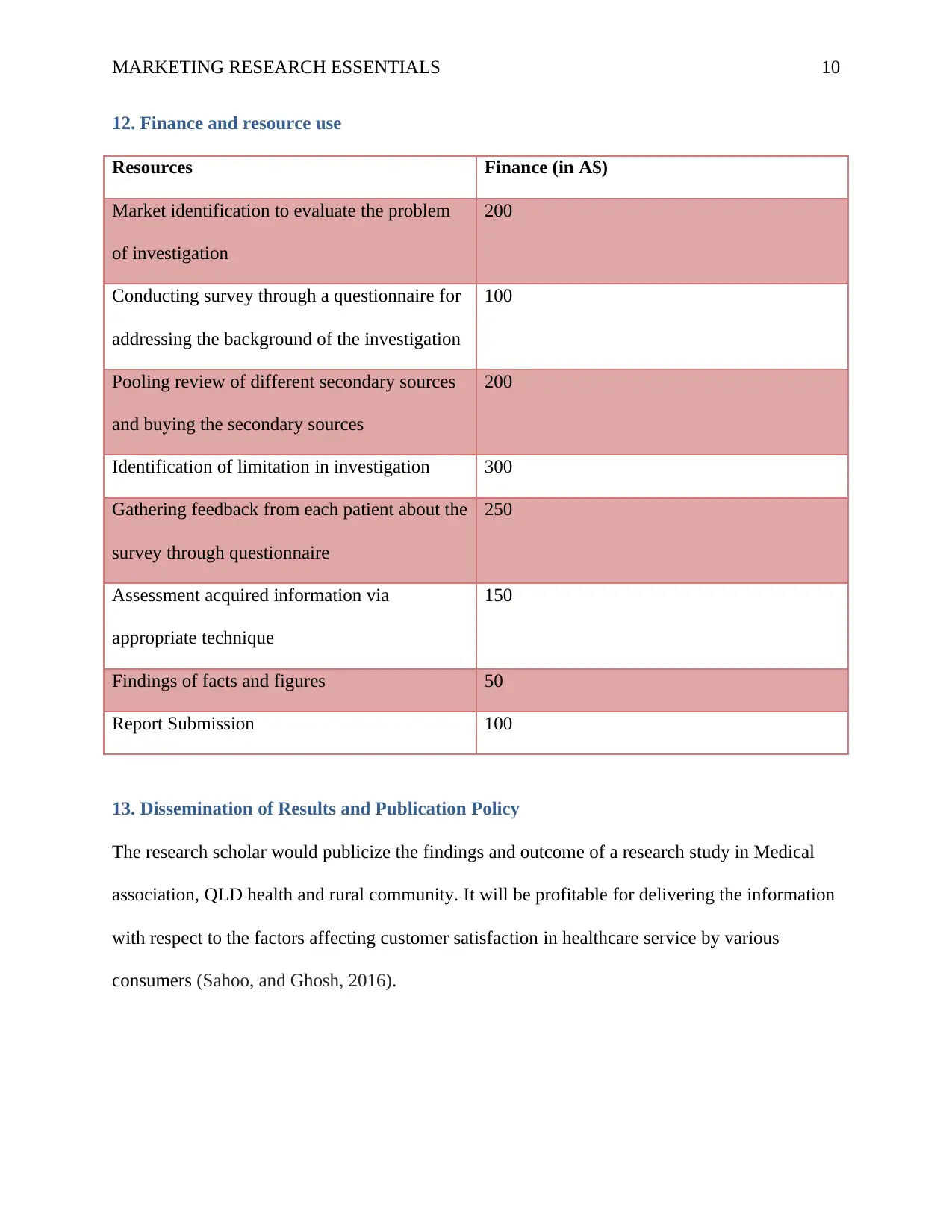
MARKETING RESEARCH ESSENTIALS 10
12. Finance and resource use
Resources Finance (in A$)
Market identification to evaluate the problem
of investigation
200
Conducting survey through a questionnaire for
addressing the background of the investigation
100
Pooling review of different secondary sources
and buying the secondary sources
200
Identification of limitation in investigation 300
Gathering feedback from each patient about the
survey through questionnaire
250
Assessment acquired information via
appropriate technique
150
Findings of facts and figures 50
Report Submission 100
13. Dissemination of Results and Publication Policy
The research scholar would publicize the findings and outcome of a research study in Medical
association, QLD health and rural community. It will be profitable for delivering the information
with respect to the factors affecting customer satisfaction in healthcare service by various
consumers (Sahoo, and Ghosh, 2016).
12. Finance and resource use
Resources Finance (in A$)
Market identification to evaluate the problem
of investigation
200
Conducting survey through a questionnaire for
addressing the background of the investigation
100
Pooling review of different secondary sources
and buying the secondary sources
200
Identification of limitation in investigation 300
Gathering feedback from each patient about the
survey through questionnaire
250
Assessment acquired information via
appropriate technique
150
Findings of facts and figures 50
Report Submission 100
13. Dissemination of Results and Publication Policy
The research scholar would publicize the findings and outcome of a research study in Medical
association, QLD health and rural community. It will be profitable for delivering the information
with respect to the factors affecting customer satisfaction in healthcare service by various
consumers (Sahoo, and Ghosh, 2016).
Paraphrase This Document
Need a fresh take? Get an instant paraphrase of this document with our AI Paraphraser
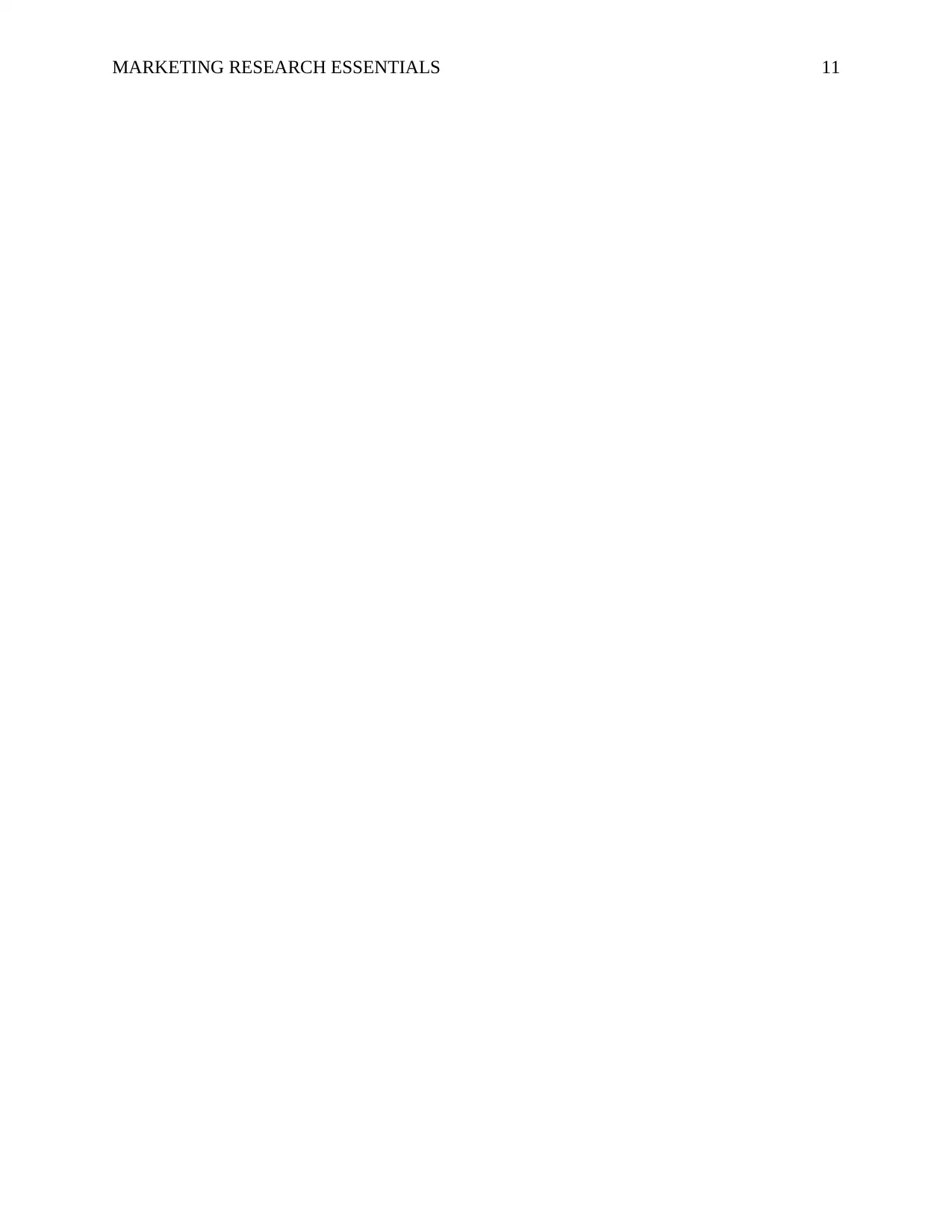
MARKETING RESEARCH ESSENTIALS 11
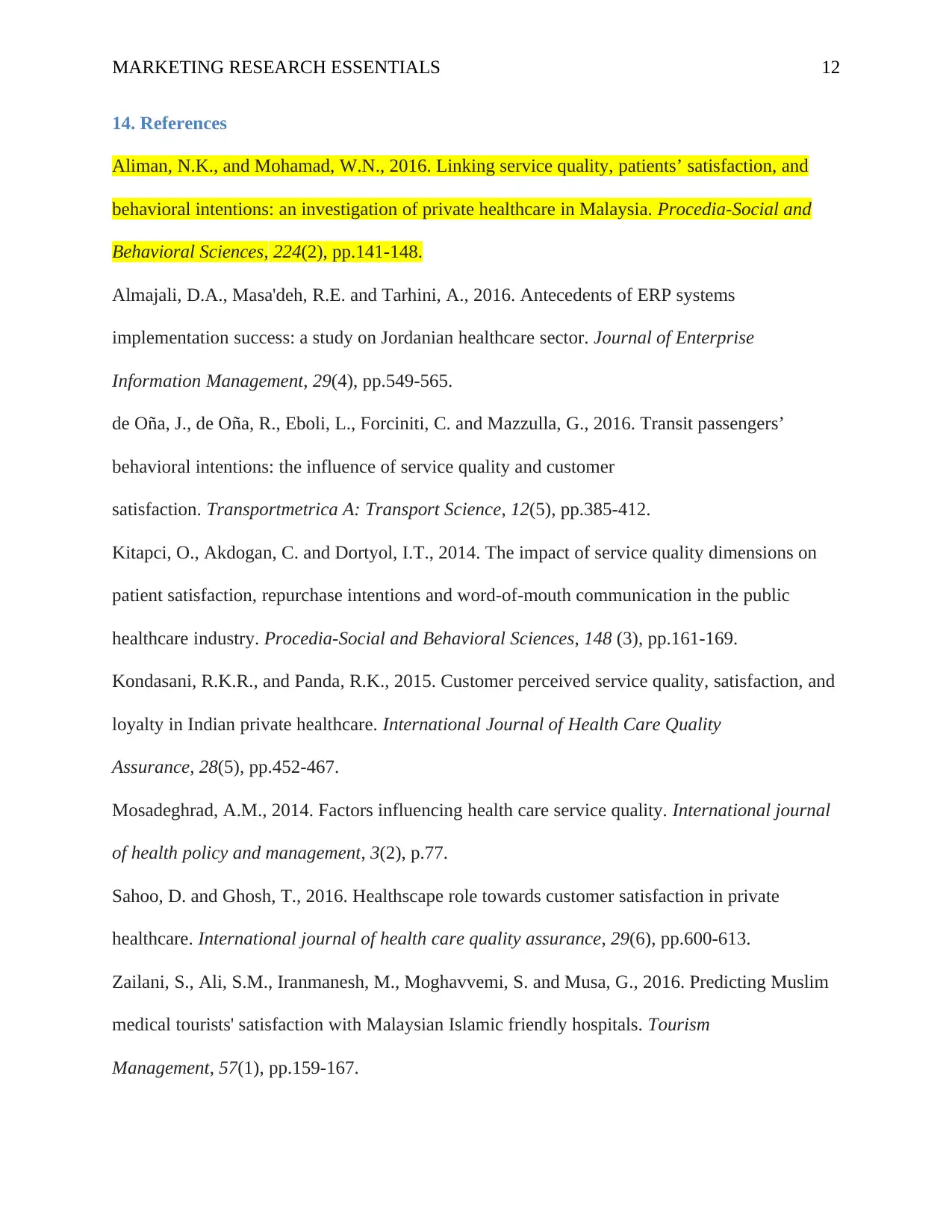
MARKETING RESEARCH ESSENTIALS 12
14. References
Aliman, N.K., and Mohamad, W.N., 2016. Linking service quality, patients’ satisfaction, and
behavioral intentions: an investigation of private healthcare in Malaysia. Procedia-Social and
Behavioral Sciences, 224(2), pp.141-148.
Almajali, D.A., Masa'deh, R.E. and Tarhini, A., 2016. Antecedents of ERP systems
implementation success: a study on Jordanian healthcare sector. Journal of Enterprise
Information Management, 29(4), pp.549-565.
de Oña, J., de Oña, R., Eboli, L., Forciniti, C. and Mazzulla, G., 2016. Transit passengers’
behavioral intentions: the influence of service quality and customer
satisfaction. Transportmetrica A: Transport Science, 12(5), pp.385-412.
Kitapci, O., Akdogan, C. and Dortyol, I.T., 2014. The impact of service quality dimensions on
patient satisfaction, repurchase intentions and word-of-mouth communication in the public
healthcare industry. Procedia-Social and Behavioral Sciences, 148 (3), pp.161-169.
Kondasani, R.K.R., and Panda, R.K., 2015. Customer perceived service quality, satisfaction, and
loyalty in Indian private healthcare. International Journal of Health Care Quality
Assurance, 28(5), pp.452-467.
Mosadeghrad, A.M., 2014. Factors influencing health care service quality. International journal
of health policy and management, 3(2), p.77.
Sahoo, D. and Ghosh, T., 2016. Healthscape role towards customer satisfaction in private
healthcare. International journal of health care quality assurance, 29(6), pp.600-613.
Zailani, S., Ali, S.M., Iranmanesh, M., Moghavvemi, S. and Musa, G., 2016. Predicting Muslim
medical tourists' satisfaction with Malaysian Islamic friendly hospitals. Tourism
Management, 57(1), pp.159-167.
14. References
Aliman, N.K., and Mohamad, W.N., 2016. Linking service quality, patients’ satisfaction, and
behavioral intentions: an investigation of private healthcare in Malaysia. Procedia-Social and
Behavioral Sciences, 224(2), pp.141-148.
Almajali, D.A., Masa'deh, R.E. and Tarhini, A., 2016. Antecedents of ERP systems
implementation success: a study on Jordanian healthcare sector. Journal of Enterprise
Information Management, 29(4), pp.549-565.
de Oña, J., de Oña, R., Eboli, L., Forciniti, C. and Mazzulla, G., 2016. Transit passengers’
behavioral intentions: the influence of service quality and customer
satisfaction. Transportmetrica A: Transport Science, 12(5), pp.385-412.
Kitapci, O., Akdogan, C. and Dortyol, I.T., 2014. The impact of service quality dimensions on
patient satisfaction, repurchase intentions and word-of-mouth communication in the public
healthcare industry. Procedia-Social and Behavioral Sciences, 148 (3), pp.161-169.
Kondasani, R.K.R., and Panda, R.K., 2015. Customer perceived service quality, satisfaction, and
loyalty in Indian private healthcare. International Journal of Health Care Quality
Assurance, 28(5), pp.452-467.
Mosadeghrad, A.M., 2014. Factors influencing health care service quality. International journal
of health policy and management, 3(2), p.77.
Sahoo, D. and Ghosh, T., 2016. Healthscape role towards customer satisfaction in private
healthcare. International journal of health care quality assurance, 29(6), pp.600-613.
Zailani, S., Ali, S.M., Iranmanesh, M., Moghavvemi, S. and Musa, G., 2016. Predicting Muslim
medical tourists' satisfaction with Malaysian Islamic friendly hospitals. Tourism
Management, 57(1), pp.159-167.
⊘ This is a preview!⊘
Do you want full access?
Subscribe today to unlock all pages.

Trusted by 1+ million students worldwide
1 out of 14
Related Documents
Your All-in-One AI-Powered Toolkit for Academic Success.
+13062052269
info@desklib.com
Available 24*7 on WhatsApp / Email
![[object Object]](/_next/static/media/star-bottom.7253800d.svg)
Unlock your academic potential
Copyright © 2020–2025 A2Z Services. All Rights Reserved. Developed and managed by ZUCOL.




